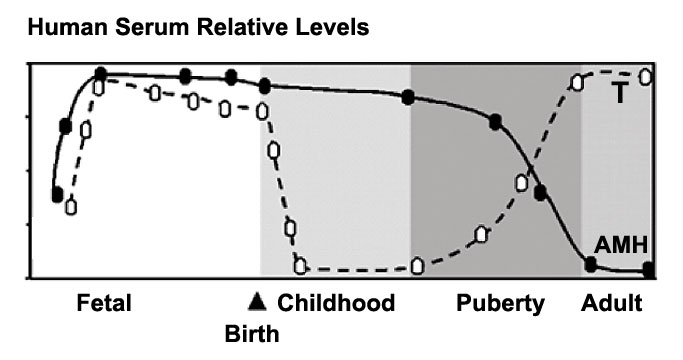File:Male testosterone and AMH level graph.jpg
From Embryology
Male_testosterone_and_AMH_level_graph.jpg (683 × 360 pixels, file size: 31 KB, MIME type: image/jpeg)
Human male testosterone and anti-Müllerian hormone (AMH) levels
- Sertoli cell-produced anti-Müllerian hormone (AMH)
- Müllerian inhibiting factor (MIF), Müllerian-inhibiting hormone (MIH), and Müllerian-inhibiting substance (MIS).
- "As already mentioned, testicular AMH production remains high during foetal life and childhood and is downregulated at puberty. The decline of AMH production by Sertoli cells is related to the stage of pubertal development: the most significant decrease in serum AMH is observed between stages II and III of pubertal development (29), in coincidence with the increase of intratesticular testosterone concentration (figure 4): the decline in AMH production is a marker of the elevation of intratesticular androgen concentration, which inhibits AMH production at puberty. Independently from androgen action, meiotic germ cells seem to play a role in downregulation of AMH expression at puberty (30,47). Interestingly, AMH is not down-regulated by testosterone during foetal life and in the first months after birth owing to the lack of expression of the androgen receptor in Sertoli cells (30). The physiological androgen insensitivity of foetal and neonatal Sertoli cells explains, thus, the transient coexistence of high concentrations of androgens and AMH (figure 4). In the absence of the negative effect of androgens and meiotic germ cells (e.g. in foetal and neonatal periods), FSH upregulates testicular AMH production. On one hand, FSH induces Sertoli cell proliferation and, on the other, it enhances AMH transcription in each Sertoli cell through a cAMP-PKA mediated signalling pathway involving transcription factors AP2 and NFB, which bind to specific response elements in distant sequences of the AMH promoter (20)."
Reference
<pubmed>16544032</pubmed>| Arq Bras Endocrinol Metabol.
All the contents of this journal, except where otherwise noted, is licensed under a Creative Commons Attribution License.
File history
Yi efo/eka'e gwa ebo wo le nyangagi wuncin ye kamina wunga tinya nan
| Gwalagizhi | Nyangagi | Dimensions | User | Comment | |
|---|---|---|---|---|---|
| current | 07:54, 22 September 2011 |  | 683 × 360 (31 KB) | S8600021 (talk | contribs) | |
| 07:43, 22 September 2011 |  | 683 × 360 (30 KB) | S8600021 (talk | contribs) | ||
| 07:35, 22 September 2011 |  | 683 × 360 (34 KB) | S8600021 (talk | contribs) | ==Human male testosterone and anti-Müllerian hormone (AMH) levels== * Sertoli cell-produced anti-Müllerian hormone (AMH) ** Müllerian inhibiting factor (MIF), Müllerian-inhibiting hormone (MIH), and Müllerian-inhibiting substance (MIS). :"As alre |
You cannot overwrite this file.
File usage
The following 16 pages use this file:
- 2011 Lab 8 - Postnatal
- 2014 Group Project 4
- ANAT2341 Lab 8 - Postnatal
- BGDB Sexual Differentiation - Late Embryo
- BGDB Sexual Differentiation - Postnatal
- BGD Lecture - Endocrine Development
- BGD Lecture - Sexual Differentiation
- Developmental Signals - Anti-Mullerian Hormone
- Endocrine - Gonad Development
- Genital - Male Development
- Lecture - Endocrine Development
- Lecture - Genital Development
- REI - Reproductive Medicine Seminar 2018
- Royal Hospital for Women - Reproductive Medicine Seminar 2018
- Testis Development
- Talk:2014 Group Project 4
